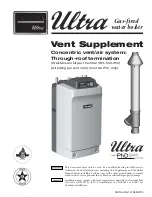
Page 110
LAARS Heating Systems
12.B.3
Main OmniTherm Controller
Each unit has an integrated controller that incorporates
manual reset high limit control, operating temperature
control, ignition control, outdoor reset control, pump
control and many other features. If any of these features
are thought to be defective, please consult the factory
for proper troubleshooting practices before replacing a
control.
If it is necessary to replace a controller, turn off all power
to the unit and shut off all manual gas valves to the
unit. Open the front doors to the unit. Remove all wire
connections from the control board. The control board
connections are keyed to only allow connection in the
proper location, but proper handling techniques should
be used to avoid damage to the wiring or connectors.
To remove the control, press the mounting tab on each
standoff while gently pulling the control board forward.
Repeat this process for all standoffs and then remove
the control. To replace the control repeat the steps listed
above in the reverse order making sure to connect all
wires in the proper locations. Place the unit in operation
following the steps outlined in SECTION 11.
12.B.4 Valve Control / Display
Each unit has a valve control display that is used to
adjust all operating parameters of the gas valve and
combustion characteristics of the unit. If it is necessary
to replace the display turn all power off to the unit.
Remove the wire connector from the back of the display.
Do NOT remove the individual wires from the connector.
Remove the 4 mounting screws holding the display to
the mounting bracket. To replace the display, repeat the
steps above in the reverse order. The wiring connector
is keyed, so proper alignment and orientation is required
when installing the wiring connector. Turn the power to
the unit back on and confirm proper display operation.
12.B.5 Spark Ignition & Flame Sensors
Electrodes
The spark ignition and flame sensor electrode is a
three rod assembly. The ground rod is fastened to the
mounting bracket. The spark and sensor electrodes
pass through ceramic insulators and then align with
the ground rod. In order for a proper spark to form,
the mounting bracket must be grounded to the boiler
chassis. To remove the electrodes, shut off the power to
the unit, turn off the main gas supply and open the front
door of the boiler to gain access to the top portion of
the unit. Remove the high tension ignition wire from the
spark electrode. Remove the flame sensor wire. Remove
the two (2) nuts and spacers holding the spark electrode
assembly in place. Pull the spark ignition electrodes out
of the boiler slowly making sure to move the assembly
as needed, so the electrodes are not bent as they are
being removed. If the old assembly is determined to be
defective, install a new electrode assembly in the reverse
order, replacing the gasket if necessary.
CAUTION
The igniters and sensors can become very hot. If
you touch these parts accidentally, this can cause
burns or injury.
12.B.6 Blower
The combustion air blower is a high pressure centrifugal
blower with a variable speed motor. The blower is driven by
the control system using a PWM signal.
If it is necessary to service, remove or replace the blower,
the Main Power MUST be disconnected and the main
gas supply to the unit must be turned off. Remove the
doors. Remove the top and side jacket panels. Remove
the fasteners holding the fuel/air mixer to the blower inlet.
Remove the hardware that is connecting the blower outlet
to the unit’s adapter plate. If the blower is determined to be
defective, replace the existing blower with a new one and
assemble in the reverse order. Be sure to install all of the
required gaskets and O-rings between the blower adapter
plate and air/fuel mixer.
12.B.7 Heat Exchanger Tubes
Black carbon soot build-up on the external surfaces
of the heat exchanger is caused by one or more of
the following: incomplete combustion, combustion air
problems, venting problems or heater short-cycling.
Soot buildup or other debris on the heat exchanger may
restrict the flue passages.
CAUTION
Black carbon soot buildup on a dirty heat exchanger
can be ignited by a random spark or flame. To
prevent this from happening, dampen the soot
deposits with a wet brush or fine water spray before
servicing the heat exchanger.
allows the entire gas valve and fuel/air mixer assembly to
be removed as an assembly to facilitate inspection and
cleaning.
After the valve has been removed, reassemble in reverse
order making sure to include all gaskets and O-rings.
Turn on the manual gas valves and check for gas leaks.
Turn on the main power. Place the unit in operation
following the instructions in SECTION 11. Once the
boiler is operating, check for leaks again and confirm all
fasteners are tight.
Check the setup for the unit according to the instructions
in SECTION 14
















































